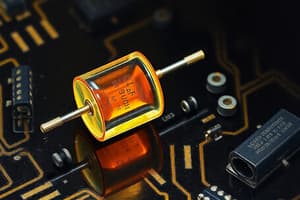Podcast
Questions and Answers
Which material has a resistivity range of $10^{-4}$ to $10^6$ ohm-m?
Which material has a resistivity range of $10^{-4}$ to $10^6$ ohm-m?
- Superconductors
- Semiconductors (correct)
- Insulators
- Conductors
What is the nature of semiconductors at 0K?
What is the nature of semiconductors at 0K?
- They behave like insulators (correct)
- They exhibit superconductivity
- Their behavior cannot be determined
- They behave like conductors
Which semiconductor materials are commonly used?
Which semiconductor materials are commonly used?
- Pb, Sn, Hg, Cd
- Ag, Au, Pt, Ni
- Si, Ge, GaAs, InP (correct)
- Al, Cu, Fe, Zn
What type of charge carriers can semiconductors have?
What type of charge carriers can semiconductors have?
What is the resistivity range of conductors?
What is the resistivity range of conductors?
What is the resistivity range of semiconductors?
What is the resistivity range of semiconductors?
What is the nature of semiconductors at 0K?
What is the nature of semiconductors at 0K?
What type of charge carriers can semiconductors have?
What type of charge carriers can semiconductors have?
Which material has a resistivity range of $10^7$ to $10^{16}$ ohm-m?
Which material has a resistivity range of $10^7$ to $10^{16}$ ohm-m?
What are the most commonly used semiconductor materials?
What are the most commonly used semiconductor materials?
Flashcards are hidden until you start studying
Study Notes
Resistivity Ranges
- Metals have a resistivity range of $10^{-8}$ to $10^{-4}$ ohm-m
- Semiconductors have a resistivity range of $10^{-4}$ to $10^6$ ohm-m
- Insulators have a resistivity range of $10^7$ to $10^{16}$ ohm-m
Semiconductors
- At 0K, semiconductors are perfect insulators
- Commonly used semiconductor materials include silicon (Si) and germanium (Ge)
- Semiconductors can have two types of charge carriers: electrons and holes
Studying That Suits You
Use AI to generate personalized quizzes and flashcards to suit your learning preferences.




